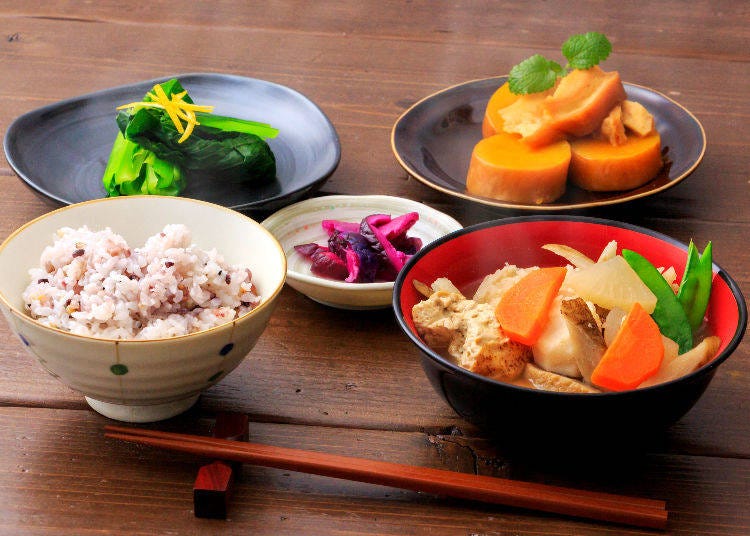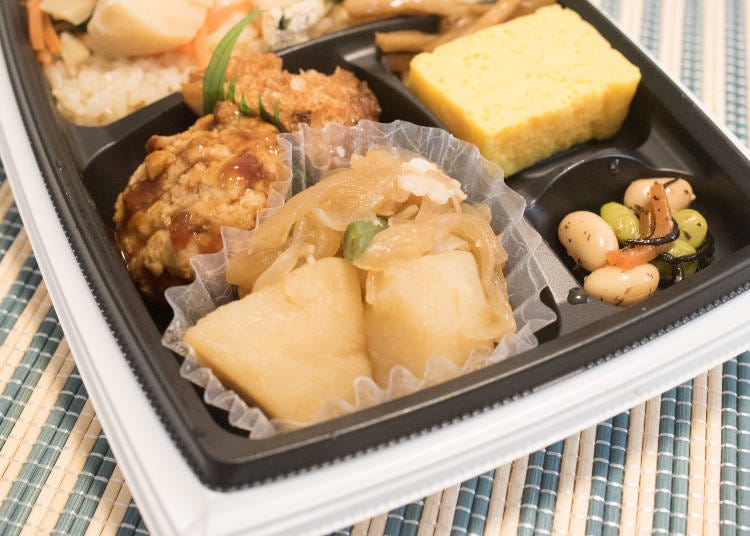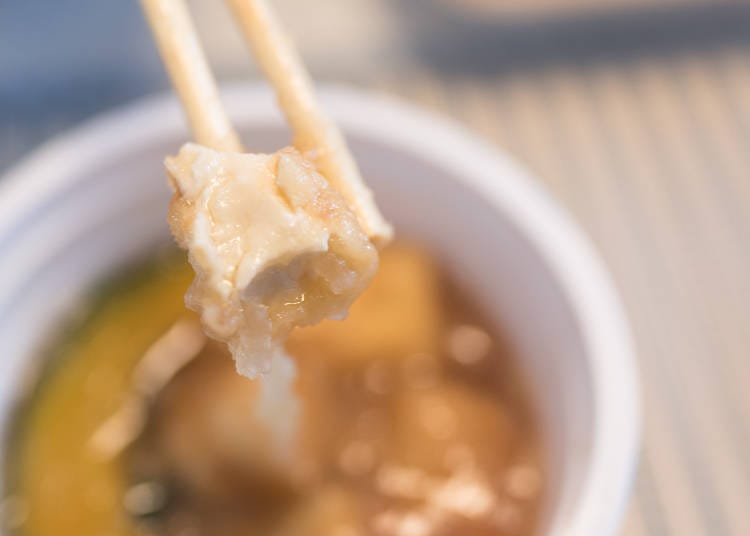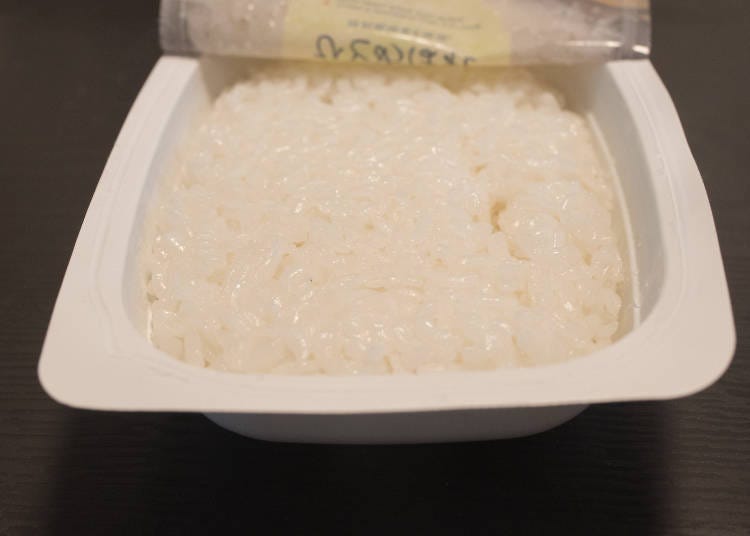
Traditional Japanese cuisine, known as washoku, was only recently officially recognized by UNESCO as an Intangible Cultural Heritage in December 2013. In light of this, there is an increasing number of non-Japanese developing an interest in this delicate cuisine.
There is also no shortage of visitors internally exclaiming “I wanna eat authentic washoku!” on their maiden visit to the land of the rising sun. But those who actually know where to enjoy good washoku in Japan are few and far between. While it is somewhat difficult to define washoku, most Japanese relate it to high-class ryōtei and refined Japanese restaurants.
In truth, washoku is not as inaccessible as it may seem. You can find a variety of washoku dishes from your “neighborhood handyman” shops to even convenience stores. Which brings us to our theme for this time’s article: introducing affordable and authentic washoku dishes in the form of convenience store boxed lunches.
For this, we took a look at the selection from one of Japan’s biggest convenience store chains, 7-Eleven, with the budget around the average lunch cost of 1,000 yen.
What is Washoku?

The origin of the term washoku comes from the words wa (representing Japan) and shoku (to mean food), or to put in simply, Japanese food. Originally, washoku was a general term used to describe local Japanese dishes, as well as traditional ones that have been in Japan since long ago. For example, dishes like sushi and tempura fit this definition. On the other hand, dishes that do not fall into this category are called "nihonshoku". These dishes originate from other countries, but have been assimilated and adapted into Japanese society, such as ramen or the like.
The generally-accepted traits of washoku are:
-“A menu comprised of 1 soup and 3 dishes that are exceedingly nutritionally-balanced.”
-“Plentiful use of seasonal ingredients (e.g. vegetables or seafood).”
-“Central dish has heavy emphasis on the dashi (Japanese soup stock made from kelp or fish) or umami.”
-“Arrangement and choice of cutlery evokes characteristics of the seasons.”
In general, the meme of “1 soup and 3 dishes” forms the foundation of washoku, but we’ll leave the details for later.
In addition, the intentional use of seasonal ingredients, emphasis on their natural umami, and attention to the presentation and thematic continuity of the dish down to the very details are the traits that give washoku its beauty. Savoriness, flavor, aroma, texture, consistency, as well as the 5 human senses, appealing to all these sensations is what truly defines washoku. In reality, however, washoku is often collectively categorized simply under “Japanese cuisine”. Washoku dishes like sushi and tempura are commonly referred to as “Japanese cuisine”―why? Simply put, consolidating everything under “Japanese cuisine” makes it easier to be understood. Truthfully, many Japanese themselves are unable to concretely define washoku. Without further ado, let’s take a look at some of the washoku options from convenience stores.
A supreme Japanese-styled bento lunch that fully makes use of seasonal ingredients - ”Takenoko Gohan Makunouchi” (540 yen)

Meals from Japanese convenience stores are of high quality, and boxed bento lunches are no exception.
First on our list is a Japanese-style boxed lunch with the main dish as “takikomi gohan” (rice seasoned and cooked with various ingredients). For good measure we included some Japanese sweets to serve as dessert.
Menu:
Takenoko Gohan Makunouchi Bentō: 540 yen
Warabi Mochi: 138 yen
Total: 678 yen
A boxed lunch full of nutrition and volume. Boiled foodstuffs and tamagoyaki make a lineup that focuses on the essence of washoku.

The generous helping of vegetables in the center of the above picture comprise of bamboo shoots. An ingredient that has always been eaten during spring in Japan, young bamboo sprouts are usually soaked in water to remove the astringent taste and softened before prepared. Traditionally, the rice is cooked together with the other ingredients like the vegetables, and using soy sauce or dashi instead of water gives the rice a light brown hue. Simply put, you get “flavored rice” infused with the rich flavor of vegetables.

Stewed or boiled dishes and deep-fried or flame-broiled dishes are often paired with takikomi gohan. For example, the boiled potatoes in the front of the picture are part of the standard Japanese home cooking dish called “nikujaga”, where potatoes and onions are boiled together in soy sauce, cooking wine and dashi.

The choice of dessert is warabi mochi, a traditional Japanese confectionery. Though its name suggests otherwise, it is not actually made from sticky rice cake. Warabi mochi is made with starch from the Bracken fern, known as “warabi” in Japan. After the starch is dissolved in water, it is kneaded while heated simultaneously. After that, the dough is cut into bite-sized pieces, completed after being steamed. Although the sweet requires a rather arduous process to make, it has always been eaten in Japan since long ago.

You won’t get enough of its unique jiggly texture. However, warabi mochi is flavorless by itself, so it is usually topped with brown sugar syrup and sprinkled with dried soybean powder. A sweet easy on the taste buds, suitable even for those trying Japanese sweets for their first time.
“The staple of boxed lunches eternally loved by Japanese - Okonomi Makunouchi” (450 yen)

In Japan, a “Makunouchi Bentō” refers to a boxed lunch consisting of white rice and an assortment of other dishes. In fact, the “Takenoko Gohan Makunouchi” that was introduced just now counts is included as well. This dish dates back to the near the end of the Edo period, or around 1716 to 1853. Apparently, when kabuki and other types of theatrical plays were getting popular, actors and stagehands while “behind-the-scenes”, or as it was called then the “Maku no Uchigawa”, would eat boxed lunches. The boxed lunch gradually grew to be called “makunouchi”, and was eventually sold to the audience as well. It was only put into mass production after the Meiji period, after 1868 or so. It eventually spread all across Japan in the form of the ekiben. Just what kind of dishes are included in this well-loved boxed lunch? Let’s take a gander.
Menu:
“Okonomi Makunouchi Bentō”: 450 yen
“Mitarashi Yakidango”: 135 yen
Total: 585 yen

Washoku dishes like saba grilled with salt and tamagoyaki are paired with Western dishes like the Hamburg Steak and croquettes. A boxed lunch that gives the impression of a meal packed with everything the typical Japanese citizen loves. The go-to for students with ravenous appetites or salarymen busy with their work.

While most of the dish consists of deep-fried or flame-broiled dishes, they are also accompanied by a plethora of vegetables dressed with sesame oil. Its refreshing taste perfectly cleanses the palate. The amount of greens while modest is actually a perfect fit. Most people will have a full belly with just this boxed lunch alone.

Mitarashi yakidango, the staple of Japanese sweets, is the dessert of choice this time around. While normally served on a skewer, these mitarashi yakidangos come in a cup for easy eating. Pick them up with the enclosed toothpick and scoop with a generous helping of red bean jam before digging in. This is a traditional Japanese snack made even easier to eat than before.
Regardless of the context, washoku in Japan is always associated with the image of high class cuisine. Not only is each item on the menu priced exorbitantly, the formality of the whole affair makes it difficult for most people to enter a washoku restaurant. However, through this set of convenience store gourmet dishes, one can enjoy washoku in a casual setting as well. If you own a thermal container, you can pack dishes that require refrigeration back to your country as well, so it’s a point worth considering.
“Made with lip-smackingly delicious dishes that represent Japan - Aona to Yuzumentaiko no Gohan”

Apart from seasonal ingredients, washoku also uses many foodstuffs that are exclusive to Japan. A prime example is mentaiko, or processed cod roe seasoned in flavoring, which possess an exquisite saltiness that goes so well with white rice many Japanese households are familiar with it in the field of home cooking. As such, this Japanese boxed lunch is the perfect meal for enjoying every aspect of this exclusive ingredient.
Menu:
“Aona to Yuzumentaiko no Gohan”: 298 yen
“Agetōfu no Mizore Soup”: 298 yen
<@“Ujimatcha and Chocolate Japanese Parfait”: 297 yen
Total: 893 yen|b@>

A bountiful boxed lunch packed with a trio of yuzumentaiko, young sardines, and greens. As you might have guessed from the name, the yuzumentaiko in the center is seasoned with flavoring from the Japanese “yuzu” citrus fruit. With spicy saltiness of the mentaiko as the base, the citrus aroma meshes to create a dish overflowing with flavor. And to add on to the taste, the dish is topped with shirasu, boiled young sardines. They are also commonly used in Italian cuisine, so some might find this a familiar ingredient. Finally, completing the dish are the crisp greens spread about the dish, perfectly accentuating the tingling spiciness.

Accompanying the boxed lunch is the dashi-filled mizore soup. It is widely used in Japan as an addition to soup or as an additional ingredient when boiling vegetables.

The main focus of the soup is the sliced deep-fried tofu. Due to its skin being highly absorbent, one bite and a flush of soup gushes out.

As for dessert, the chocolate matcha parfait is a veritable blend of Eastern and Western flavors. The rich sweetness of the chocolate together with the mature bitterness of matcha result in a dish that adults may favor.

The dango, often referred to as white gems, serve as the topping. Mixing it with the chocolate and matcha cream produces a tempting combination.
An extravagant meal for only a thousand yen! An authentic washoku course meal from the convenience store

Our last showcase is an example of how a dish embodying the washoku ideal of 1 soup and 3 dishes can be created with just convenience store food. In this case, 1 soup, 1 main dish and 2 accompanying dishes are required.
Below are the exact conditions each dish has to fulfill.
Staple dish: Rice
Soup: Miso soup or any dish meant to hydrate one’s mouth.
Main Dish: Fish or egg dish that is light in flavor.
Side Dish: A dish that makes up for the nutrients lacking in the main dish, usually vegetables.
Auxiliary Side Dish: Additional greens, pickled or dressed with sauce, to cleanse the palate.
Each dish having a clear role in the overall meal is a unique trait of washoku. The real question, however, is if an authentic washoku meal with each required role being genuinely fulfilled can be made solely from 7-Eleven’s food. First off, the two dishes mentioned above have fulfilled two places: the former fulfilling the role of staple food and the latter, that of the auxiliary side dish.

The packed rice can be prepared simply by peeling off a small section of the film and heating it in a microwave. Despite being prepared in a microwave, the rice has the same feel as freshly-prepared rice. It might be a good idea to stock up a few packs, as it is very easy to store.

Miso soup with freeze dried spring onions fills the soup position. Just pour hot water into a bowl with it and it can be eaten immediately, Like one of the previous recommendations, the choice of the main dish this time is also mackerel broiled with salt. Same as the packed rice, simply heating it in a microwave is enough to prepare it.

For the role of the side dish, “chikuzenni”, made with 7 types of ingredients was chosen. Chikuzenni is a dish consisting of braised chicken and vegetables, boiled with a mix of dashi, sugar, and soy sauce. Again, microwaving it is sufficient enough for it to be ready to eat.

Well, what do you think? A staple dish, together with soup, 1 main dish, 1 side dish and finally, 1 auxiliary side dish. Put these 5 items together, and a true washoku meal embodying the “1 soup 3 dishes” ideal is created. Since most of the dishes are microwaveable, it’ll only take 15 minutes to prepare this full course.

The staple food, the rice, has a fluffiness that makes it hard to believe it was microwaved. People with experience cooking rice might be knowledgeable about this, but cooking rice well is not a simple affair. Too much water can result in rice too soft, whereas too little would give it too hard a texture. As such, making the perfect bowl of white rice is an endeavor in itself. However, with this packed rice, all that needs to be done is to heat it for a minute, and anyone can enjoy delicious fluffy white rice.

The miso soup with plenty of spring onions is also a fine dish, with the dashi showing its work well. Other than spring onions, there are also other packs of freeze dried miso soup that contain other ingredients like tofu and nameko mushrooms, so do try out lots of the different variations.

The salt-broiled hokke (mackerel) is a standard dish of Japanese home cooking. Similar to the rice, the layer of oil coating the surface of the mackerel gives it a finish not unlike freshly prepared ones. Other than hokke, 7-Eleven also carries other types of grilled fish, such as salmon and saba. The saba, in particular, is so popular that not even a single pack could be procured for this review. That isn’t to say that the hokke isn’t delicious, though. It’s highly recommended for those who haven’t tried it before.

The chikuzenni stands out as well, with its huge shiitake mushrooms. The soy sauce base gives it a slightly strong flavor. The main ingredients are chicken, shiitake mushrooms, konjac, carrot, burdock, bamboo shoots, and lotus roots. Perhaps due to the moderate amount of vegetables, this is a healthy dish with plenty of volume.

You can never go wrong with pickled vegetables in washoku either. Small dishes or snacks accompanying meals are often called hashiyasume in Japan. In this case, pickled veggies are a perfect fit, requiring only a single slice to cleanse the palate. Other than refreshing one’s taste buds, it helps spice up the flavors in one’s meal. This particular dish consists of cucumbers, radishes and chinese cabbages.
Lastly, a brief look at the cost of this meal, both in calories and in money.
Staple food: Rice > 123 yen /288kcal
Soup: Miso Soup with Spring Onions > 98 yen /288kcal
Main dish: Salt-broiled Hokke > 300 yen /133kcal
Side dish: Chikuzenni > 246 yen /129kcal|b@>
Auxiliary side dish: Pickled vegetables > 257 yen /34kcal
Total Price: 1030 yen
Total Calories: 610kcal
With regards to the pickled vegetables, not everything in the packet is served at once. Normally, whatever amount in the packet is divided accordingly to meals, so if calculated accurately, the total price and calorie count of this meal should be less than what is written here as well. Nevertheless, one can enjoy a full washoku course for a mere thousand yen, and the meal contains only a little more than 600kcal. In any case, it is clear that washoku is a healthy meal choice, with a low calorie count. A perfect option for anyone visiting Japan for their first time.
*Prices and options mentioned are subject to change.
*Unless stated otherwise, all prices include tax.
Popular Tours & Activitiess
Recommended places for you
-

This Winter, Godzilla Takes Over Haneda Airport
by: Guest Contributor
-
Ad

Preserving the Beauty of World Heritage Site Shirakawa-go for the Future Through Responsible Travel
-

First Japan Cherry Blossom 2026 Forecast Announced! Here's When & Where to See Sakura in Japan
-
Ad

Complete Guide to Ueno’s National Museum of Nature and Science, the Perfect Place to Visit on Rainy Days or With Children
-
Ad

(Opening in Jan 2026) 'THE SUMO LIVE RESTAURANT HIRAKUZA GINZA TOKYO!' 5 Exciting Ways to Experience the World of Sumo!
-

Strawberries, Style, and Tokyo’s Coolest Neighborhood: Winter Afternoon Tea in Kichijoji
by: Guest Contributor
Inspiration for Accommodations
-

Enjoy Mt. Fuji from the Comfort of Your Room! Recommended Ryokan with Mt. Fuji View
-

Stay Near the Cherry Blossoms! Hotels for Cherry Blossom Viewing in Tokyo
-

Family-Friendly Hotels with Free Shuttle to Disneyland: Convenient Access for a Magical Stay
-

Top Ranked Hakone Hotels with Mt. Fuji View: Enjoy Stunning Scenery from Your Private Space
-

Convenient Tokyo Hotels with Airport Shuttle: Ideal for Families and Heavy Luggage
-

Stunning Tokyo Tower View Hotels: Enjoy Spectacular Scenery from Your Private Space
-

Convenient Asakusa Hotels with Kitchens: Ideal for Extended Family Visits
-

Experience Luxury: Hakone's 10 Best Five-Star Accommodations
-

Enjoy Mt. Fuji Autumn Leaves! Top Hotels Near the Popular Autumn Leaves Corridor
-

Experience Hakone Fall Foliage from Your Room with Stunning Views
-

The Top 3 Photo Spots in Roppongi
-

What to Pack for Japan: 8 Essential Things for a Hassle-Free Trip
-

Quirky Japanese Phrases: The Adaptable 'Daijōbu' and Appropriate Situations to Use It
-

Ultimate Tokyo Transit Guide: JR, Subways, and Private Railways Explained, Plus Suica/PASMO and Money-Saving Passes
-

Easy Day Trip from Tokyo! Ultimate Sightseeing Guide for Hakone & Lake Ashinoko!
-

Discover Tokyo's Best Gift Shops: Bring Home Unique Souvenirs From Japan
- #best ramen tokyo
- #what to buy in ameyoko
- #what to bring to japan
- #new years in tokyo
- #best izakaya shinjuku
- #things to do tokyo
- #japanese nail trends
- #what to do in odaiba
- #onsen tattoo friendly tokyo
- #daiso
- #best sushi ginza
- #japanese convenience store snacks
- #best yakiniku shibuya
- #japanese fashion culture
- #best japanese soft drinks


















